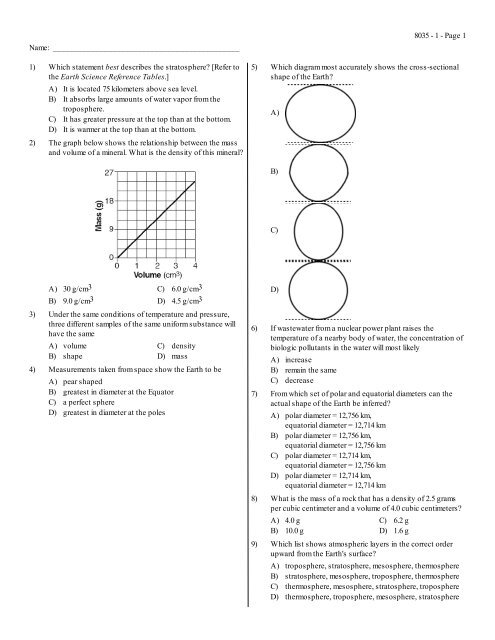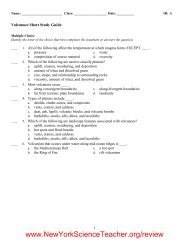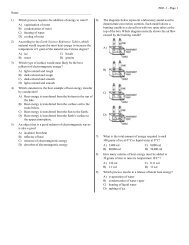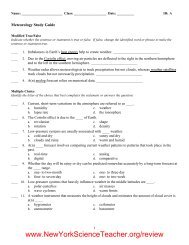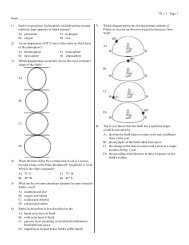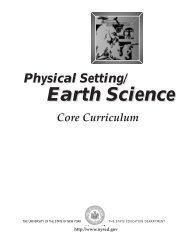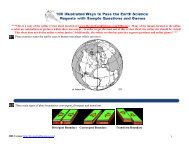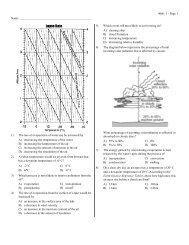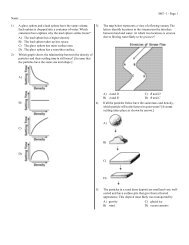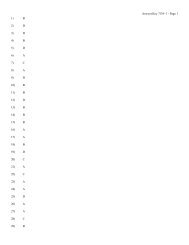Name - Earth Science Regents Review
Name - Earth Science Regents Review
Name - Earth Science Regents Review
- No tags were found...
Create successful ePaper yourself
Turn your PDF publications into a flip-book with our unique Google optimized e-Paper software.
<strong>Name</strong>: ____________________________________________1) Which statement best describes the stratosphere? [Refer tothe <strong>Earth</strong> <strong>Science</strong> Reference Tables.]A) It is located 75 kilometers above sea level.B) It absorbs large amounts of water vapor from thetroposphere.C) It has greater pressure at the top than at the bottom.D) It is warmer at the top than at the bottom.2) The graph below shows the relationship between the massand volume of a mineral. What is the density of this mineral?5) Which diagram most accurately shows the cross-sectionalshape of the <strong>Earth</strong>?A)8035 - 1 - Page 1B)C)A) 30 g/cm3C) 6.0 g/cm3B) 9.0 g/cm3D) 4.5 g/cm33) Under the same conditions of temperature and pressure,three different samples of the same uniform substance willhave the sameA) volumeB) shapeC) densityD) mass4) Measurements taken from space show the <strong>Earth</strong> to beA) pear shapedB) greatest in diameter at the EquatorC) a perfect sphereD) greatest in diameter at the polesD)6) If wastewater from a nuclear power plant raises thetemperature of a nearby body of water, the concentration ofbiologic pollutants in the water will most likelyA) increaseB) remain the sameC) decrease7) From which set of polar and equatorial diameters can theactual shape of the <strong>Earth</strong> be inferred?A) polar diameter = 12,756 km,equatorial diameter = 12,714 kmB) polar diameter = 12,756 km,equatorial diameter = 12,756 kmC) polar diameter = 12,714 km,equatorial diameter = 12,756 kmD) polar diameter = 12,714 km,equatorial diameter = 12,714 km8) What is the mass of a rock that has a density of 2.5 gramsper cubic centimeter and a volume of 4.0 cubic centimeters?A) 4.0 gB) 10.0 gC) 6.2 gD) 1.6 g9) Which list shows atmospheric layers in the correct orderupward from the <strong>Earth</strong>'s surface?A) troposphere, stratosphere, mesosphere, thermosphereB) stratosphere, mesosphere, troposphere, thermosphereC) thermosphere, mesosphere, stratosphere, troposphereD) thermosphere, troposphere, mesosphere, stratosphere
Questions 10 and 11 refer to the following:The data table below shows the air pressures and air temperaturescollected by nine observers at different elevations on the sameside of a high mountain. The data was collected at 12:00 noon on aclear, calm day.12) Which diagram best represents the <strong>Earth</strong> with the oceandepth drawn to scale?A)8035 - 1 - Page 2B)C)10) Based on the data collected, which graph best representsthe relationship between elevation above sea level and airpressure?D)A)B)C)D)11) From sea level to an elevation of 1,200 meters, air pressuredecreased at the rate ofA) 10.0 mb/mB) 1.0 mb/mC) 100.0 mb/mD) 0.1 mb/m13) A student classifies several objects. The classificationsystem should be based onA) interpretationsB) inferencesC) observationsD) hypotheses14) The actual polar diameter of the <strong>Earth</strong> is 12,714 kilometers.The equatorial diameter of the <strong>Earth</strong> is approximatelyA) 12,757 kmB) 12,714 kmC) 12,700 kmD) 12,671 km15) According to the <strong>Earth</strong> <strong>Science</strong> Reference Tables, ifatmospheric pressure measurements were taken at regularintervals from sea level to the stratopause, themeasurements would most likely show that the pressureA) decreases, onlyB) increases, onlyC) decreases, then increasesD) remains the same16) In which atmospheric layer is most water vapor found?A) thermosphereB) mesosphereC) troposphereD) stratosphere17) The solid rock material that directly underlies the sedimentson the ocean floor is part of the <strong>Earth</strong>'sA) troposphereB) lithosphereC) hydrosphereD) outer core18) According to the <strong>Earth</strong> <strong>Science</strong> Reference Tables, what isthe temperature of the atmosphere at the stratopause?A) -55DCC) 15DCB) 0DCD) -90DC
19) What are the best frames of reference for describingchange?A) volume and massB) time and distanceC) speed and densityD) weight and temperature20) The table below identifies four density groups.23) Which graph best represents the most common relationshipbetween the amount of air pollution and the distance froman industrial city?A)8035 - 1 - Page 3B)According to this classification system, a sample of quartzwith a mass of 27 grams and a volume of 10 cubiccentimeters should be placed in groupA) A B) B C) C D) D21) According to the <strong>Earth</strong> <strong>Science</strong> Reference Tables, the mostabundant gas in the troposphere isA) oxygenB) carbon dioxideC) nitrogenD) water vapor22) Which graph best shows the general relationship betweenthe population density of an area (x-axis) and the amount ofpollution in the area (y-axis)?A)B)C)C)D)24) The total amount of water vapor per cubic meter in theatmosphere at sea level is approximatelyA) 1 g/m3C) 15 g/m3B) 8 g/m3D) 30 g/m325) Students calculated the circumference of a globe to be60. centimeters. The actual circumference of the globe is63 centimeters. The percent deviation of the students'calculation wasA) 0.48%B) 4.8%C) 21%D) 5.0%26) The best example of a noncyclic event isA) a phase change of the MoonB) a volcanic eruptionC) an apparent star movementD) a change of seasonsD)
27) The data table below shows the stream discharge in Aprilfor a creek in the southern United States for a period of8 days.Which graph most accurately shows stream discharge forthe 8-day period?A)B)C)D)28) Oxygen is the most abundant element by volume in the<strong>Earth</strong>'sA) hydrosphereB) inner coreC) crustD) troposphere29) Which statement about a rock sample is most likely aninference?A) The rock is made of small, dark-colored crystals.B) The rock has thin, distinct layers.C) The rock has flat sides and sharp corners.D) The rock has changed color due to weathering.30) According to the <strong>Earth</strong> <strong>Science</strong> Reference Tables, asaltitude increases from the tropopause to the mesopause,the atmospheric temperature willA) increase, then decreaseB) decrease, onlyC) decrease, then increaseD) increase, only31) The primary purpose of a classification system is to enablepeople toA) extend their powers of observationB) eliminate inaccurate inferencesC) organize observations in a meaningful wayD) make measurements that are very accurate32) While walking on a glacier, an observer makes severalstatements. Which statement is an inference?A) "Some parts of this glacier will start melting thisspring."B) "There are many cracks in this glacier."C) "The rocks on this glacier are of different sizes."D) "Some of the snow on this glacier is powdery."33) According to the <strong>Earth</strong> <strong>Science</strong> Reference Tables, thetemperature in the stratosphere ranges from approximatelyA) 10DF to 35DFC) 10DC to 50DCB) -55DF to 0DFD) -55DC to 0DC34) A student determines the density of a mineral to be3.5 grams per cubic centimeter. If the accepted value is4.8 grams per cubic centimeter, what is the student'sapproximate percent error?A) 73%B) 37%C) 13%D) 27%35) According to the <strong>Earth</strong> <strong>Science</strong> Reference Tables, what isthe approximate thickness of the troposphere?A) 27 kmB) 50 kmC) 7 kmD) 12 km8035 - 1 - Page 436) An interface is best described as aA) region where no changes are occurringB) region that lies just below the surface of the <strong>Earth</strong>C) boundary across which energy may be exchangedD) change in the state of the environment37) The use of a triple-beam balance to determine the mass of arock is an example of measuring by usingA) all of the five sensesB) a direct comparison with a standardC) inferences and interpretationsD) a combination of dimensional quantities
38) Water has the greatest density atA) 100DC in the gaseous phaseB) 4DC in the solid phaseC) 0DC in the solid phaseD) 4DC in the liquid phase39) The best evidence that the <strong>Earth</strong> has a spherical shapewould be provided byA) the prevailing wind direction at many locations on the<strong>Earth</strong>'s surfaceB) photographs of the <strong>Earth</strong> taken from spaceC) the time the <strong>Earth</strong> takes to rotate on its axis at differenttimes of the yearD) the change in the time of sunrise and sunset at a singlelocation during 1 year40) The graph below represents percentage of elements byvolume.According to the <strong>Earth</strong> <strong>Science</strong> Reference Tables, thisgraph best represents the elements of the <strong>Earth</strong>'sA) hydrosphereB) stratosphereC) lithosphereD) troposphere41) Which layer of the atmosphere has the greatest density?A) stratosphereB) thermosphereC) troposphereD) mesosphere42) A student determines the density of a rock to be 2.2 gramsper cubic centimeter. If the accepted density of the rock is2.5 grams per cubic centimeter, what is the percent deviation(percentage of error) from the accepted value?A) 13.6%B) 12.0%C) 30.0%D) 8.8%8035 - 1 - Page 543) A pebble has a mass of 35 grams and a volume of 14 cubiccentimeters. What is its density?A) 2.5 g/cm3C) 4.0 g/cm3B) 490 g/cm3D) 0.4 g/cm3Questions 44 through 46 refer to the following:The table below shows data for a student's collection of rock samples A through I, which are classified into groups X, Y, and Z. Foreach rock sample, the student recorded mass, volume, density, and a brief description. The density for rock D has been left blank.
44) Which statement is an inference rather than an observation?A) Rock E has a volume of 33.1 cm3.B) Rock G is the same color as rock I.C) Rock B has been rounded by stream action.D) Rock H is flat.45) The approximate density of rock sample D isA) 3.75 g/cm3C) 2.75 g/cm3B) 3.32 g/cm3D) 2.67 g/cm38035 - 1 - Page 646) The student broke rock G into two pieces. Compared to thedensity of the original rock, the density of one piece wouldmost likely beA) greaterB) lessC) the same47) The diagram below shows air movements associated with cumulus cloud formation over a lake during a summer day. A, B, C, andD are reference points.Point D is 10 kilometers above the <strong>Earth</strong>'s surface. In which layer of the atmosphere is point D located?A) upper stratosphere B) lower stratosphere C) lower mesosphere D) upper troposphereQuestions 48 through 50 refer to the following:The Bay of Fundy, located on the east coast of Canada, has the highest ocean tides in the world. The St. John River enters the Bay ofFundy at the city of St. John, where the river actually reverses direction twice a day at high tides. Data for the famous Reversing Fallsof the St. John River are given below for high and low tides on June 26 through 28, 1994.48) Compared to the first high tide on June 26, how much laterin the day did the first high tide occur on June 27?A) 10 minB) 5 h 40 minC) 50 minD) 1 h 10 min
49) Which graph best represents the tides recorded on June 28?A)50) Tides in the Bay of Fundy are best described asA) predictable and cyclicB) unpredictable and noncyclicC) unpredictable and cyclicD) predictable and noncyclic8035 - 1 - Page 7B)C)D)


